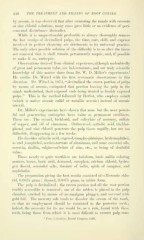Page 442 - My FlipBook
P. 442
;
440 THE TREATMENT AND FILLING OF ROOT CANALS.
by arsenic, it was ol^scrvcd that after saturatino; the canals with creosote
or zinc chh)ri(l sohitions, many cases gave little or no evidence of peri-
cemental distnrbance thereafter.
While it is unquestionably preferable to always thoroughly remove
the last vestige of devitalized pulps, the time, care, skill, and expense
involved in perfect cleansing are detriments to its universal practice.
The only other possible solution of the difficulty is to so alter the tissue
not removed that it shall remain permanently aseptic, and, if possible
to make it so, antiseptic.
Observations derived from clinical experience, although undoubtedly
of great and permanent value, are indeterminate, and our truly scientific
knowledge of this matter dates from Dr. W. 1). Miller's experiments.^
He credits Dr. Witzel with the first systematic observations in this
direction. Dr. Witzel in 1874, "devitalized the crown portion of pulps
by means of arsenic, extirpated that portion leaving the pulp in the
canals undisturbed, their exposed ends being treated as freshly exposed
pulps." This is the method followed by Herbst, who employs cobalt
(which is native arsenic sulfid or metallic arsenic) instead of arsenic
trioxid.
Dr. Miller's experiments have shown that none but the most power-
ful and penetrating antiseptics have value as permanent sterilizers.
These are : The cyanid, bichlorid, and salicylate of mercury, sulfate
of copper, and oil of cinnamon. Orthocresol, carbolic acid, trichlor-
phenolj and zinc chlorid penetrate the pulp tissue rapidly, but are too
difiusible, disappearing in a few weeks.
He classifies salicylic acid, eugenol, campho-phenique, hydronaphthol,
a- and ^5-naplithol, acetico-tartrate of aluminum, and some essential oils,
resorcin, thallin, sulpho-carbolate of zinc, etc., as being of doubtful
value.
Those nearly or quite w^orthless are iodoform, basic anilin coloring
matters, borax, boric acid, dermatol, europhen, calcium chlorid, hydro-
gen dioxid, sozoiodol salts, tincture of iodin, spirit of camphor, and
naphthalin.
The preparation giving the best results consisted of—^Mercuric chlo-
rid, 0.0075 gram ; thymol, 0.0075 gram, in tablet form.
The pulp is devitalized ; the crown portion and all the root portion
readily accessible is removed ; one of the tablets is placed in the pulp
chamber, crushed by means of an amalgam plugger, and covered with
gold foil. The mercury salt tends to discolor the crown of the to(jth,
so that its employment should be restricted to the posterior teetli
indeed, the necessity for its use would be, as a rule, found with these
teeth, being those from which it is most difficult to extract pulp rem-
^ Proc. Columbian Dental Congress, 1893.
440 THE TREATMENT AND FILLING OF ROOT CANALS.
by arsenic, it was ol^scrvcd that after saturatino; the canals with creosote
or zinc chh)ri(l sohitions, many cases gave little or no evidence of peri-
cemental distnrbance thereafter.
While it is unquestionably preferable to always thoroughly remove
the last vestige of devitalized pulps, the time, care, skill, and expense
involved in perfect cleansing are detriments to its universal practice.
The only other possible solution of the difficulty is to so alter the tissue
not removed that it shall remain permanently aseptic, and, if possible
to make it so, antiseptic.
Observations derived from clinical experience, although undoubtedly
of great and permanent value, are indeterminate, and our truly scientific
knowledge of this matter dates from Dr. W. 1). Miller's experiments.^
He credits Dr. Witzel with the first systematic observations in this
direction. Dr. Witzel in 1874, "devitalized the crown portion of pulps
by means of arsenic, extirpated that portion leaving the pulp in the
canals undisturbed, their exposed ends being treated as freshly exposed
pulps." This is the method followed by Herbst, who employs cobalt
(which is native arsenic sulfid or metallic arsenic) instead of arsenic
trioxid.
Dr. Miller's experiments have shown that none but the most power-
ful and penetrating antiseptics have value as permanent sterilizers.
These are : The cyanid, bichlorid, and salicylate of mercury, sulfate
of copper, and oil of cinnamon. Orthocresol, carbolic acid, trichlor-
phenolj and zinc chlorid penetrate the pulp tissue rapidly, but are too
difiusible, disappearing in a few weeks.
He classifies salicylic acid, eugenol, campho-phenique, hydronaphthol,
a- and ^5-naplithol, acetico-tartrate of aluminum, and some essential oils,
resorcin, thallin, sulpho-carbolate of zinc, etc., as being of doubtful
value.
Those nearly or quite w^orthless are iodoform, basic anilin coloring
matters, borax, boric acid, dermatol, europhen, calcium chlorid, hydro-
gen dioxid, sozoiodol salts, tincture of iodin, spirit of camphor, and
naphthalin.
The preparation giving the best results consisted of—^Mercuric chlo-
rid, 0.0075 gram ; thymol, 0.0075 gram, in tablet form.
The pulp is devitalized ; the crown portion and all the root portion
readily accessible is removed ; one of the tablets is placed in the pulp
chamber, crushed by means of an amalgam plugger, and covered with
gold foil. The mercury salt tends to discolor the crown of the to(jth,
so that its employment should be restricted to the posterior teetli
indeed, the necessity for its use would be, as a rule, found with these
teeth, being those from which it is most difficult to extract pulp rem-
^ Proc. Columbian Dental Congress, 1893.


